
Have you ever struggled to turn your steering wheel, feeling like you’re wrestling with your car instead of smoothly guiding it? 🚗💪 This frustrating experience might be a sign of a failing power steering pump. As the unsung hero of your vehicle’s steering system, the power steering pump plays a crucial role in making your drive effortless and enjoyable.
But what exactly is a power steering pump, and why should you care? 🤔 Whether you’re a car enthusiast or simply someone who wants to keep their vehicle in top shape, understanding this vital component can save you from unexpected headaches and costly repairs. From recognizing the warning signs of a failing pump to exploring alternatives in modern vehicles, we’re about to embark on a journey through the world of power steering systems.
In this comprehensive guide, we’ll dive deep into the inner workings of power steering pumps, explore common issues, and provide you with practical tips for maintenance and replacement. So, buckle up and get ready to steer your way through six essential aspects of power steering pumps that every driver should know! 🚗💨
Understanding Power Steering Pumps
What is a power steering pump?
A power steering pump is a crucial component of a vehicle’s power steering system. It’s responsible for pressurizing and circulating the power steering fluid, which assists in turning the wheels with minimal effort from the driver. This hydraulic pump transforms the mechanical energy from the engine into hydraulic pressure, making steering smoother and more manageable, especially at low speeds or when the vehicle is stationary.
How does it work?
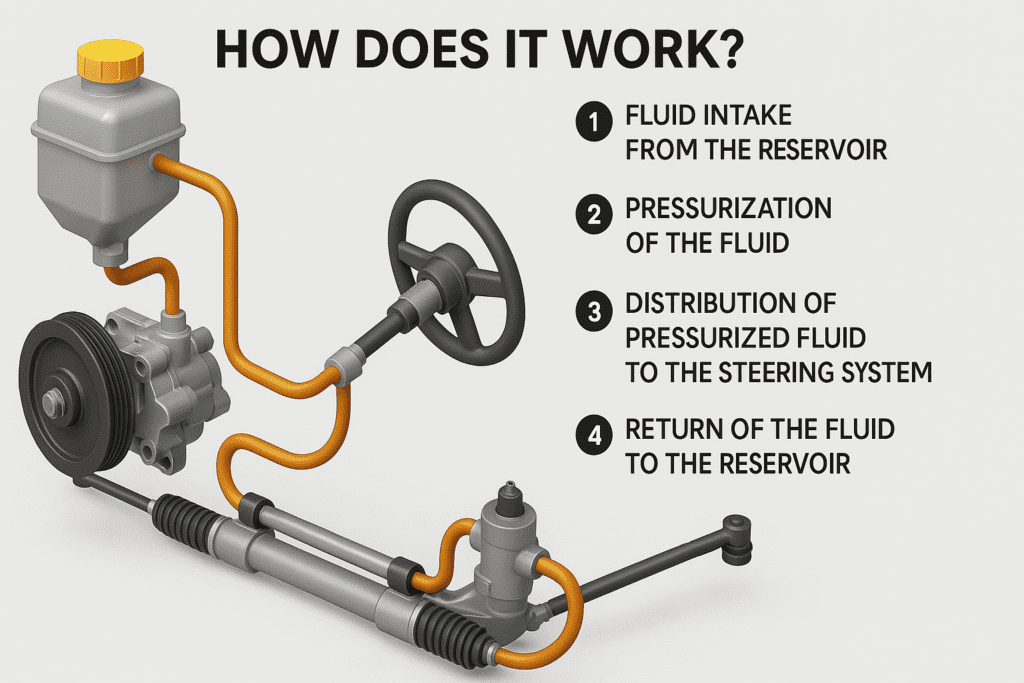
The power steering pump operates by drawing power steering fluid from a reservoir and pressurizing it. This pressurized fluid is then sent through hoses to the steering gear or rack. As the driver turns the steering wheel, the pressurized fluid helps to move the steering mechanism, reducing the effort required to turn the wheels.
The process can be broken down into these steps:
- Fluid intake from the reservoir
- Pressurization of the fluid
- Distribution of pressurized fluid to the steering system
- Return of the fluid to the reservoir
Types of power steering pumps
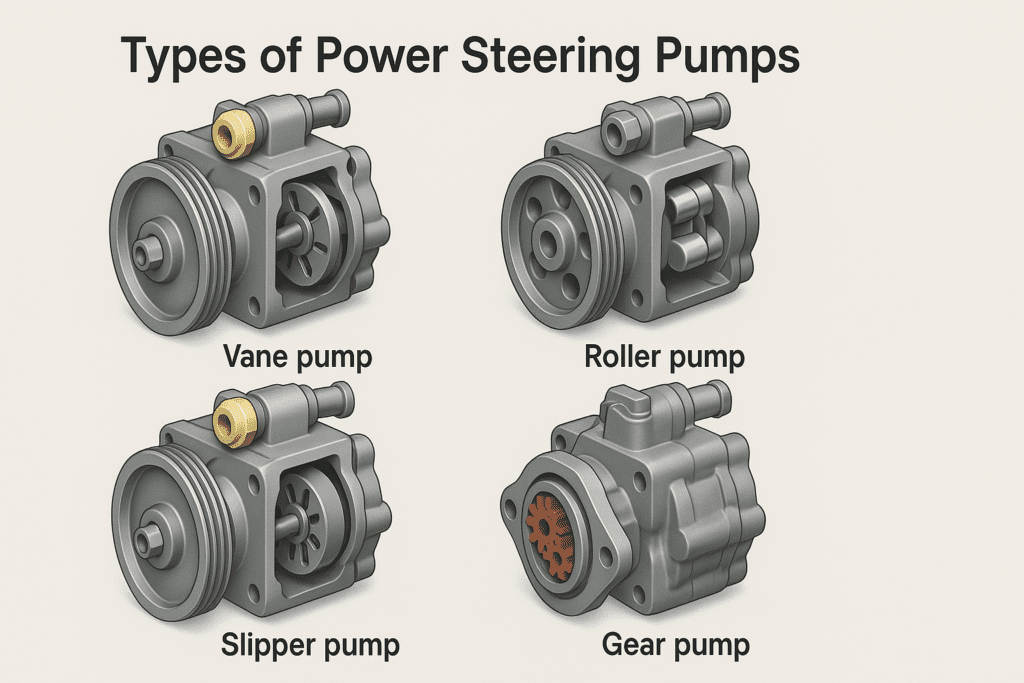
There are several types of power steering pumps, each with its own characteristics:
- Vane pumps
- Roller pumps
- Slipper pumps
- Gear pumps
Here’s a comparison of these pump types:
| Pump Type | Efficiency | Noise Level | Durability | Cost |
|---|---|---|---|---|
| Vane | High | Low | Good | Moderate |
| Roller | Moderate | Moderate | Excellent | High |
| Slipper | High | Low | Good | Moderate |
| Gear | Moderate | High | Excellent | Low |
Components of a power steering pump
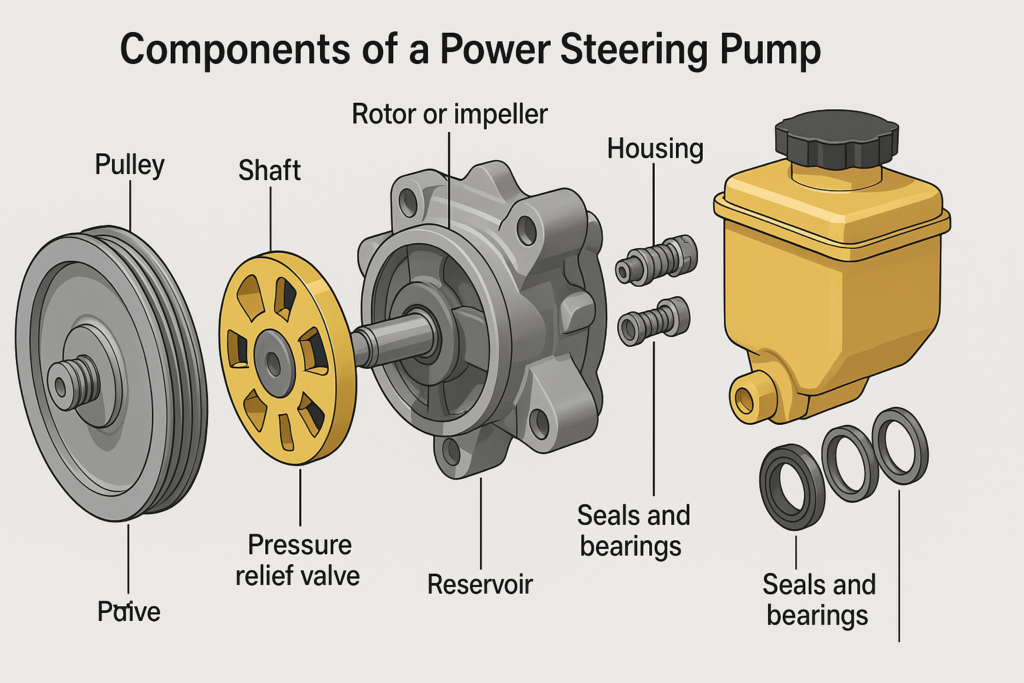
A typical power steering pump consists of several key components:
- Pulley: Connects the pump to the engine’s drive belt
- Shaft: Transfers rotational energy from the pulley to the pump mechanism
- Rotor or impeller: The main pumping element that pressurizes the fluid
- Housing: Contains and supports the internal components
- Pressure relief valve: Regulates the maximum pressure in the system
- Flow control valve: Manages the fluid flow rate
- Reservoir: Stores and supplies power steering fluid
- Seals and bearings: Prevent leaks and reduce friction
Understanding these components is crucial for diagnosing issues and maintaining the power steering system. Regular inspection of these parts can help prevent failures and ensure smooth operation of the power steering system.
Now that we’ve covered the basics of power steering pumps, let’s look at the signs that might indicate your pump is failing. These symptoms can help you identify potential issues before they lead to more serious problems.
Visit website: Autobiography Zone
Signs of a Failing Power Steering Pump
Whining noise while turning
One of the most common signs of a failing power steering pump is a distinct whining noise when turning the steering wheel. This high-pitched sound typically becomes more noticeable during low-speed maneuvers or when the vehicle is stationary. The whining occurs due to insufficient fluid pressure or worn internal components within the pump.
Difficulty steering
As the power steering pump deteriorates, you may experience increased resistance when turning the steering wheel. This can manifest as:
- Heavy steering, especially at low speeds
- Uneven steering effort (easier in one direction than the other)
- Sudden loss of power assist while driving
These symptoms indicate that the pump is struggling to maintain proper fluid pressure, making it harder for you to control the vehicle.
Leaking power steering fluid
A visible leak is a clear indicator of power steering pump issues. Power steering fluid is typically red or pink, though it may darken with age. Common leak locations include:
- Around the pump shaft seal
- At the pump’s mounting points
- Along the high-pressure hose connections
Here’s a table showing the characteristics of power steering fluid leaks:
| Leak Severity | Fluid Color | Leak Location | Action Required |
|---|---|---|---|
| Minor | Light red/pink | Small puddle under car | Monitor and top up fluid |
| Moderate | Dark red/brown | Visible drips on ground | Inspect and repair soon |
| Severe | Very dark/black | Large puddles, low fluid level | Immediate repair needed |
Squealing noise on startup
A squealing or screeching noise when you start your vehicle can indicate a problem with the power steering pump’s drive belt or pulley. This sound is often caused by:
- A loose or worn belt
- Misaligned pulleys
- Failing bearings in the pump
The noise may subside as the engine warms up, but it’s crucial to address this issue promptly to prevent further damage.
Intermittent power steering assistance
Inconsistent power steering performance is another telltale sign of a failing pump. You might notice:
- Sudden loss of power assist while driving
- Power steering that works fine one moment and fails the next
- Steering that becomes increasingly difficult as you drive
These symptoms often occur due to:
- Low power steering fluid levels
- Air in the power steering system
- Failing pump internal components
- Electrical issues in the power steering system
If you experience any of these signs, it’s essential to have your power steering system inspected by a qualified mechanic. Ignoring these symptoms can lead to complete power steering failure, compromising your vehicle’s safety and handling. Regular maintenance and prompt attention to these warning signs can help extend the life of your power steering pump and ensure smooth, safe driving.
Maintaining Your Power Steering Pump
Regular fluid checks and top-ups

Maintaining the proper fluid level in your power steering system is crucial for its longevity and performance. Regular checks and top-ups ensure smooth operation and prevent damage to the pump and other components.
To check the fluid level:
- Locate the power steering reservoir under the hood
- Clean the cap and surrounding area to prevent contamination
- Remove the cap and inspect the dipstick or fluid level indicator
- Add fluid if necessary, using the manufacturer-recommended type
It’s best to check your power steering fluid at least once a month or before long trips. Always use the correct type of fluid specified in your vehicle’s manual to avoid compatibility issues.
Flushing the power steering system
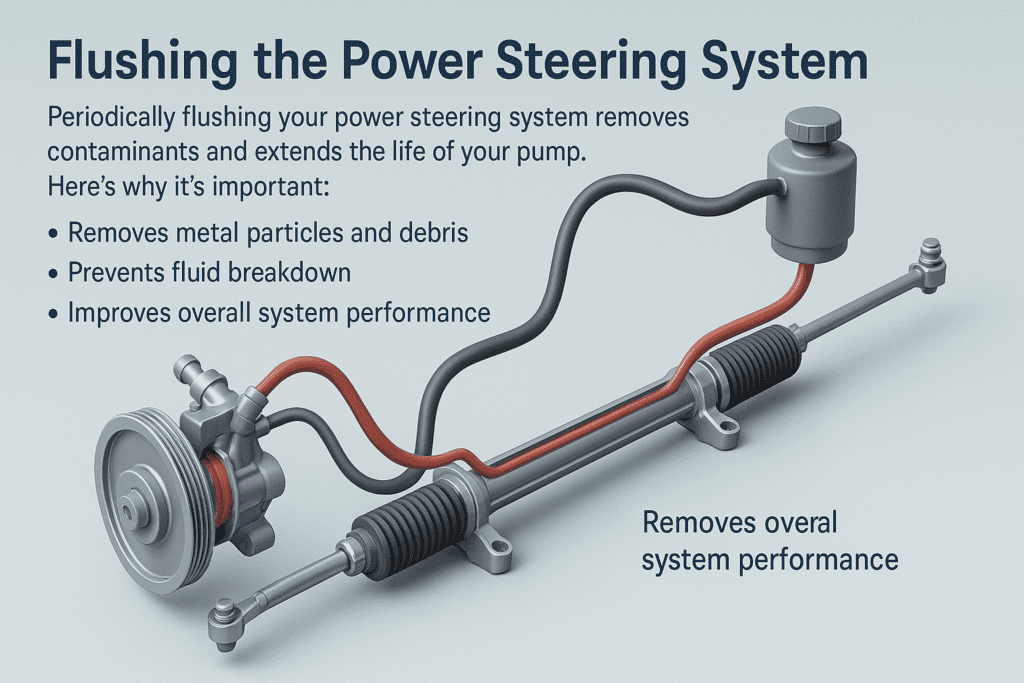
Periodically flushing your power steering system removes contaminants and extends the life of your pump. Here’s why it’s important:
- Removes metal particles and debris
- Prevents fluid breakdown
- Improves overall system performance
| Flushing Frequency | Vehicle Usage |
|---|---|
| Every 2 years | Normal driving |
| Every year | Severe conditions |
| As recommended | Consult manual |
To flush the system, you’ll need to drain the old fluid, refill with new fluid, and run the engine to circulate it. This process may need to be repeated several times for a thorough flush.
Inspecting hoses and connections
Regular inspection of power steering hoses and connections is vital for preventing leaks and ensuring system integrity. Look for:
- Cracks or splits in hoses
- Loose or damaged clamps
- Signs of fluid leakage
- Unusual wear or rubbing
Address any issues promptly to avoid more significant problems down the road. Replace worn hoses and tighten loose connections as needed.
Proper driving habits to prolong pump life
Your driving habits can significantly impact the lifespan of your power steering pump. Here are some tips to reduce strain on the system:
- Avoid holding the steering wheel at full lock for extended periods
- Turn the wheel smoothly and gradually, especially when stationary
- Maintain proper tire pressure to reduce steering effort
- Allow the engine to warm up before making sharp turns
By implementing these maintenance practices and driving habits, you can significantly extend the life of your power steering pump and ensure smooth, responsive steering. Regular attention to your power steering system not only improves your driving experience but also helps avoid costly repairs in the future.
Now that we’ve covered how to maintain your power steering pump, let’s move on to what you need to know when it’s time for a replacement.
Replacing a Power Steering Pump
When replacement is necessary
When your power steering pump shows signs of severe wear or failure, replacement becomes necessary. This typically occurs when you experience persistent steering difficulties, unusual noises, or fluid leaks that can’t be resolved through repairs. Here are some key indicators that it’s time for a replacement:
- Consistent whining or groaning noises while turning the wheel
- Steering wheel stiffness or resistance, especially at low speeds
- Visible power steering fluid leaks under the vehicle
- Erratic or inconsistent power steering assistance
- Dashboard warning lights related to the power steering system
If you notice multiple symptoms or if the issues persist after attempting repairs, it’s likely time to replace your power steering pump.
DIY vs. professional replacement
Deciding between a DIY replacement and professional service depends on your mechanical skills, tools, and time availability. Let’s compare the two options:
| Aspect | DIY Replacement | Professional Replacement |
|---|---|---|
| Cost | Lower upfront cost | Higher cost, but includes labor |
| Time | Can be time-consuming for novices | Typically faster completion |
| Expertise | Requires mechanical knowledge | Performed by trained technicians |
| Tools | May need to purchase or rent specific tools | All necessary tools available |
| Warranty | Usually limited to parts only | Often includes labor warranty |
| Complexity | Can be challenging for inexperienced mechanics | Handled efficiently by professionals |
For those with automotive experience and proper tools, a DIY replacement can be a cost-effective option. However, for most drivers, professional replacement ensures proper installation and can save time and potential frustration.
Choosing the right replacement pump
Selecting the correct replacement pump is crucial for optimal performance and longevity. Consider these factors when choosing a new power steering pump:
- Vehicle compatibility: Ensure the pump matches your car’s make, model, and year
- OEM vs. aftermarket: Decide between original equipment manufacturer parts or aftermarket alternatives
- Quality and durability: Research brands and read reviews to find reliable options
- Warranty coverage: Look for pumps with good warranty terms
- Performance specifications: Consider flow rate and pressure ratings suitable for your vehicle
It’s advisable to consult your vehicle’s manual or a trusted mechanic to ensure you select a compatible and high-quality replacement pump.
Cost considerations
The cost of replacing a power steering pump can vary significantly based on several factors:
- Vehicle make and model
- Pump quality and brand
- Labor costs (if professionally installed)
- Additional parts needed (e.g., hoses, fittings)
On average, you can expect to pay between $200 to $700 for parts alone, with high-end or luxury vehicles potentially costing more. Labor costs typically range from $200 to $400, depending on your location and the complexity of the installation.
To manage costs effectively:
- Get multiple quotes from reputable mechanics
- Consider both OEM and high-quality aftermarket options
- Check if your vehicle’s warranty covers any part of the replacement
- Inquire about any available discounts or promotions
Remember that while cost is an important factor, prioritizing quality and proper installation will help ensure the longevity and performance of your new power steering pump.
Alternatives to Traditional Power Steering Pumps
Electric power steering systems
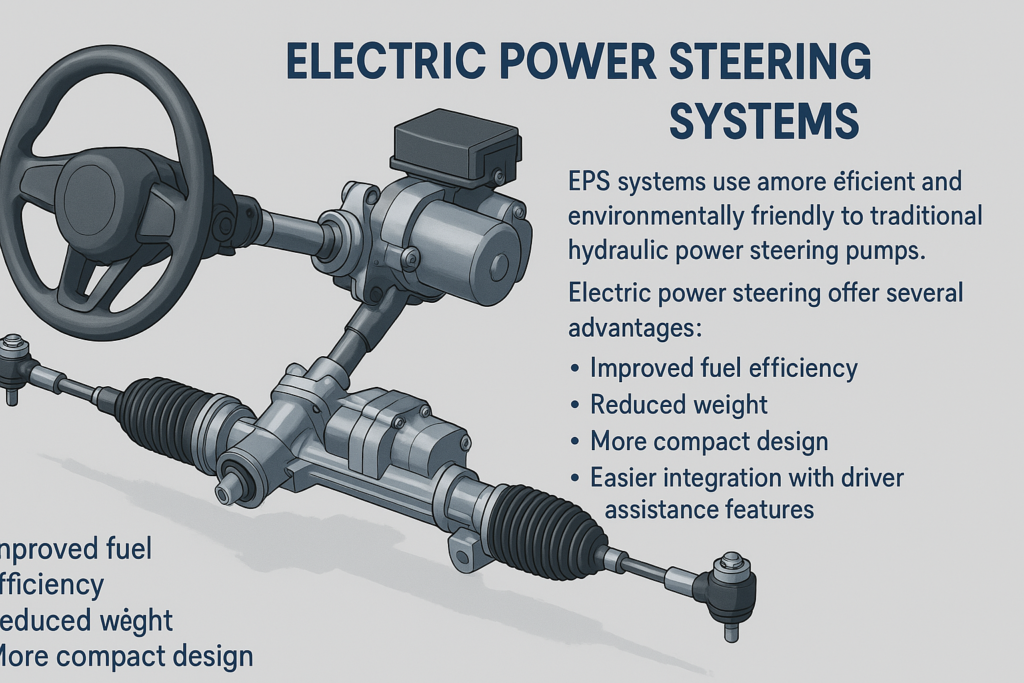
Electric power steering (EPS) systems have become increasingly popular in modern vehicles, offering a more efficient and environmentally friendly alternative to traditional hydraulic power steering pumps. These systems use an electric motor to assist with steering, eliminating the need for a hydraulic pump and fluid.
EPS systems offer several advantages:
- Improved fuel efficiency
- Reduced weight
- More compact design
- Easier integration with driver assistance features
One of the key benefits of EPS is its ability to adjust steering assistance based on vehicle speed and driving conditions, providing a more responsive and natural steering feel.
Hydraulic-electric hybrid systems
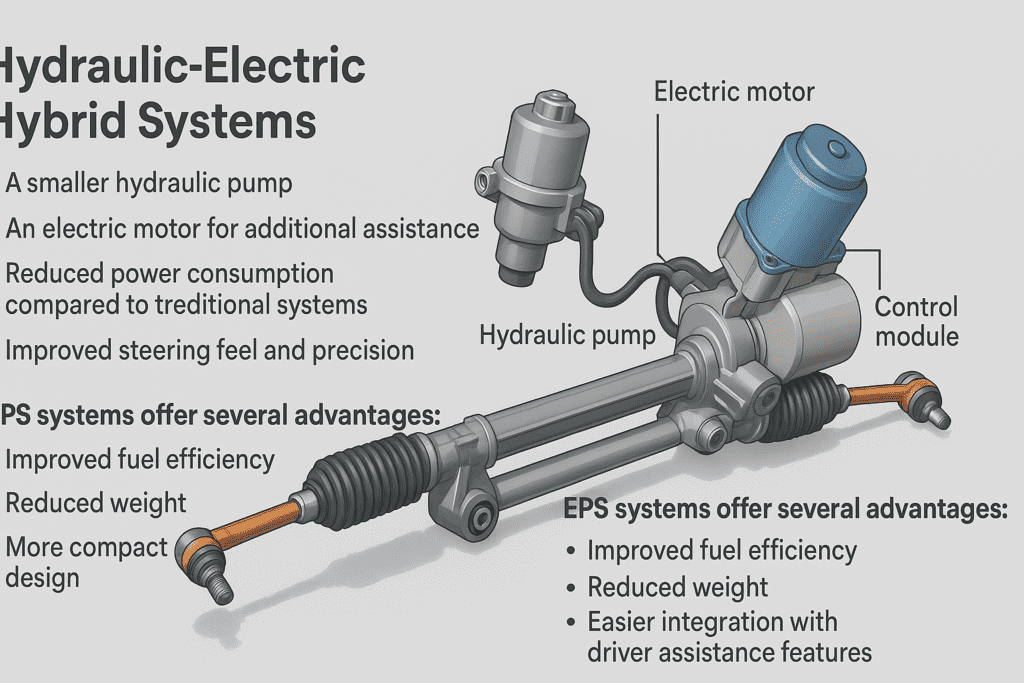
Hydraulic-electric hybrid steering systems combine elements of both traditional hydraulic power steering and electric power steering. This technology aims to bridge the gap between the two, offering the best of both worlds.
Key features of hydraulic-electric hybrid systems include:
- A smaller hydraulic pump
- An electric motor for additional assistance
- Reduced power consumption compared to traditional systems
- Improved steering feel and precision
These systems are particularly useful in larger vehicles or those with high steering loads, where pure electric systems may struggle to provide sufficient assistance.
Visit website: Autobiography Zone
Steer-by-wire technology
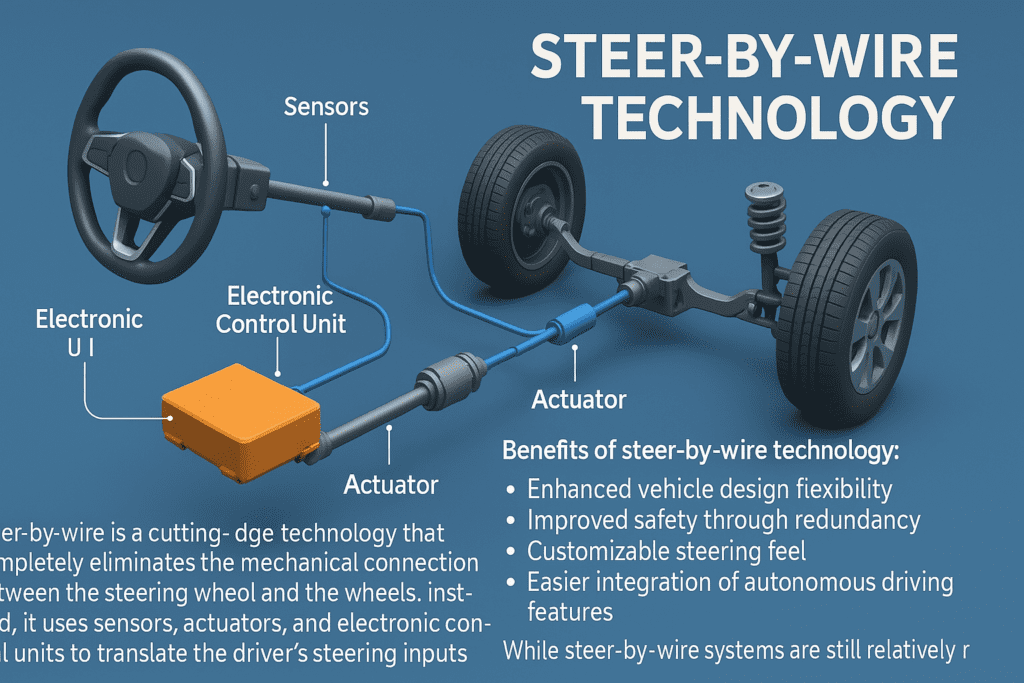
Steer-by-wire is a cutting-edge technology that completely eliminates the mechanical connection between the steering wheel and the wheels. Instead, it uses sensors, actuators, and electronic control units to translate the driver’s steering inputs into wheel movements.
Benefits of steer-by-wire technology:
- Enhanced vehicle design flexibility
- Improved safety through redundancy
- Customizable steering feel
- Easier integration of autonomous driving features
While steer-by-wire systems are still relatively rare in production vehicles, they represent the future of steering technology and are likely to become more common in the coming years.
Benefits of modern steering technologies
Modern steering technologies offer numerous advantages over traditional power steering pumps. Let’s compare these benefits in a table:
| Technology | Fuel Efficiency | Weight Reduction | Customization | Integration with ADAS |
|---|---|---|---|---|
| EPS | High | Significant | Good | Excellent |
| Hybrid | Moderate | Moderate | Good | Good |
| Steer-by-wire | High | Significant | Excellent | Excellent |
These advanced steering systems not only improve vehicle performance and efficiency but also enhance the overall driving experience. As automotive technology continues to evolve, we can expect to see further innovations in steering systems that prioritize safety, comfort, and environmental sustainability.
Now that we’ve explored the alternatives to traditional power steering pumps, let’s address some frequently asked questions about power steering systems in general.
10 FAQs
What is a power steering pump?
A power steering pump is a crucial component of a vehicle’s power steering system. It generates hydraulic pressure to assist in turning the wheels, making steering easier and more comfortable for the driver.
How long does a power steering pump typically last?
The lifespan of a power steering pump varies depending on driving conditions and maintenance, but it generally lasts between 100,000 to 200,000 miles. Regular maintenance can significantly extend its life.
What are the common symptoms of a failing power steering pump?
Common signs include:
- Whining or groaning noise when turning the wheel
- Stiff or difficult steering
- Fluid leaks under the vehicle
- Squealing noise upon starting the engine
Can I drive with a faulty power steering pump?
While it’s possible to drive with a faulty pump, it’s not recommended. Steering becomes much harder, increasing the risk of accidents. It’s best to address the issue promptly to ensure safe driving.
How much does it cost to replace a power steering pump?
Replacement costs vary depending on the vehicle make and model. Here’s a general price range:
| Cost Type | Price Range |
|---|---|
| Parts | $100 – $500 |
| Labor | $200 – $400 |
| Total | $300 – $900 |
Is it possible to repair a power steering pump instead of replacing it?
In some cases, minor issues can be repaired. However, if the pump is severely damaged or worn, replacement is often the more cost-effective and reliable solution.
How often should I check my power steering fluid?
It’s recommended to check your power steering fluid at least once a month or during every oil change. Regular checks can help identify potential issues early.
Can I use any type of power steering fluid in my vehicle?
No, it’s crucial to use the specific type of power steering fluid recommended by your vehicle manufacturer. Using the wrong fluid can damage the system and void warranties.
What’s the difference between hydraulic and electric power steering?
Key differences include:
- Hydraulic: Uses fluid pressure generated by a pump
- Electric: Uses an electric motor to assist steering
Electric systems are generally more efficient and require less maintenance.
How can I maintain my power steering pump?
To maintain your power steering pump:
- Check fluid levels regularly
- Replace fluid as recommended by the manufacturer
- Inspect belts and hoses for wear
- Address any unusual noises or steering issues promptly
Regular maintenance can significantly extend the life of your power steering pump and ensure smooth, safe driving. With proper care, you can avoid costly repairs and enjoy responsive steering for many miles to come.
Power steering pumps play a crucial role in modern vehicles, making steering effortless and enhancing overall driving safety. By understanding the signs of a failing pump, such as difficulty steering or unusual noises, drivers can take proactive steps to maintain their vehicle’s steering system. Regular maintenance, including fluid checks and timely replacements, can significantly extend the life of a power steering pump and prevent costly repairs.
For those facing power steering issues, replacing the pump or exploring alternatives like electric power steering systems can offer long-term solutions. Whether you’re a DIY enthusiast or prefer professional assistance, staying informed about your vehicle’s power steering system is essential for a smooth and safe driving experience. Remember, a well-maintained power steering pump contributes to better vehicle control and safer roads for everyone.
Visit website: Autobiography Zone
